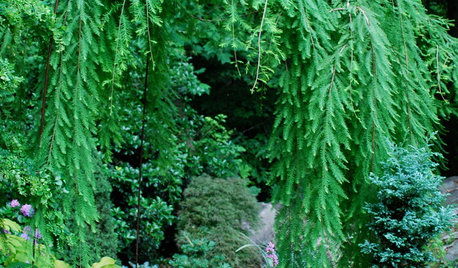Difference between Cardinal Vine and Cypress Vine
cribscreek
18 years ago
Featured Answer
Sort by:Oldest
Comments (25)
roberta_nc
18 years agoalicia7b
18 years agoRelated Discussions
is red cypress vine the same as trumpet vine?
Comments (5)Hi, They are different. Trumpet vine is a native perennial vine while Cypress vine is an annual. There is also a slight difference between Cypress Vine and Cardinal Climber even though their names get interchanged often (even among the seed companies, reputable ones at that!). Both are annuals, flowers pretty much the same but the foliage is very different. I personally like the foliage of the Cardinal Climber better. I would do research on the perennial Trumpet Vine if you decide to go with that one. I had planned on growing it but upon further research, I was frightened off. I live in warm zone 8 and Trumpet vine sounded just a tad bit more of a hearty grower than what I am willing to deal with. But like I said, I'm in a much different growing zone than you. Besides, a neighbor has it so I'll just enjoy hers from afar ;) Here are some links for Cardinal Climber and Cypress Vine. I am not endorsing the seed company at all since I have never delt with them so I can not vouch for their good business practices. The drawings on the seed packets do depict the foliage of each accurately. http://www.gardenguides.com/seedcatalog/flowers/cardinalclimber.htm http://www.gardenguides.com/seedcatalog/flowers/cypressvine.htm...See Morewanted cypress and cardinal vine seeds
Comments (1)Email me what you have to trade....See MoreCardinal Climber or Cypress Vine?
Comments (3)I've grown both and have found that the cardinal climber isn't as invasive when it reseeds. I also like the larger cut of the foliage. The cypress vine is more fern like. I see some bindweed in that last picture too. :) I have some growing in the woods behind the house. The hummers love it too, but it is extremely invasive and reseeds with 100%+ germination....See MoreCardinal Climber, Cypress vine, Morning Glory quesions??
Comments (1)Hyacinth Bean is supposed to grow well here in MI z5, gets quite large. It is an annual. Our local Garden Column writer had an article on it a while ago, as a suggestion for next summer. I think the flowers are pink. Moonflower might be a night-blooming vine to think about. Looks like white Morning Glory. Scent is very attractive for some folks. Also an annual. You might try starting some things from seed, get a head start. I always bought my Cardinal plants, so they got bloom time, were growing well before the end of summer. Clematis is a great vine, comes in many colors and various flower shapes. It is a perennial, so it can take a couple years to really get going well. However the flower reward is worth it, in my opinion. There are 3 bloom periods, which the different named plants can use. Some are early season, others mid-season, while others bloom in late summer, early fall. Just check the labels, so you know which time to expect bloom, when to trim the vines back. Lots of good information on the Clematis forum here on GW. I have had great luck with the clematis plants with Polish names, Pope John Paul II, and a purple one, can't remember it. Terrific bloom over long time period, starting the first year. I was pretty surprised at that. Has just gotten even better since!...See Morecribscreek
18 years agoalicia7b
18 years agolindanc
18 years agolindanc
18 years agoalicia7b
18 years agoClaire Pickett
18 years agoalicia7b
18 years agoAnnie
18 years agoClaire Pickett
18 years agoalicia7b
18 years agoClaire Pickett
18 years agoalicia7b
18 years agoClaire Pickett
18 years agoalicia7b
18 years agoClaire Pickett
18 years agotamelask
18 years agoalicia7b
18 years agobrenda_near_eno
18 years agoalicia7b
18 years agovera_eastern_wa
17 years agotamelask
17 years agotrianglejohn
17 years ago
Related Stories

GARDENING GUIDESBackyard Birds: Northern Cardinals in the Snow, and Other Red Birds
Brilliant crimson feathers make these friends stand out in a crowd
Full Story
FENCES AND GATES12 Delightfully Different Garden Walls and Fences
If pickets seem picked over and you shrink from chain link, try these full-of-personality fencing alternatives
Full Story
LANDSCAPE DESIGNThe 7 Best Plant Types for Creating Privacy and How to Use Them
Follow these tips for using different kinds of plants as living privacy screens
Full Story
LANDSCAPE DESIGNThe Weepers and the Creepers: 10 Intriguing Trees for Your Garden
Bring something a little different to your landscape with a tree that dives, twists or crawls
Full Story
PATIOSGet Backyard Privacy the Subtler, Stylish Way
Why settle for a hulking brick wall when plants, screens and other refined backyard dividers do the job with panache?
Full Story
GARDENING AND LANDSCAPINGLay of the Landscape: Mediterranean Garden Style
Earthy, lush and warmly welcoming, a Mediterranean garden can thrive in any warm-climate landscape with a few adaptations
Full Story
EXTERIORSWhere Front Yards Collide: Property Lines in Pictures
Some could be twins; others channel the Odd Couple. You may never look at property boundaries the same way again
Full Story
GARDENING FOR BUTTERFLIESGarden for Wildlife to Reap Rich Rewards
When you plant with animals and insects in mind, you make gardening easier, the planet healthier and yourself more present
Full Story
GARDENING GUIDESGrow a Beautiful Garden in Alkaline Soil
Got alkaline soil? Learn how to manage it and the many beautiful plants that will thrive in this ‘sweet’ soil
Full Story
GARDENING GUIDESBackyard Birds: Invite Entertaining Hummingbirds Into Your Garden
Hummingbirds — unique to the Americas — zip through open landscapes seasonally or year-round. Here’s how to attract them
Full Story


tamelask